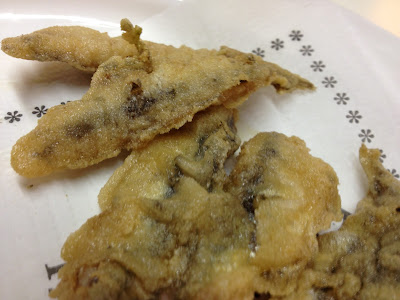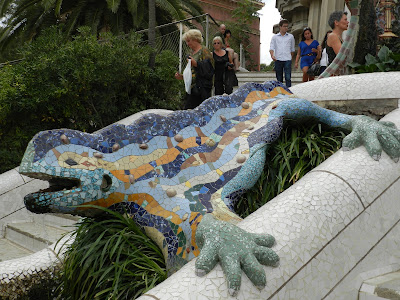So, let me guess: you want to know about the food, right? Thought so. I wish I could be more helpful, but a couple of things stood in the way. First, I was mostly there to write an article, which meant I couldn't roam around as much as I wanted to. Second, I was with other people, which was both good and bad: good because one of them was quite knowledgeable, bad because when we were in a group, they weren't.
Thus, one thing that was missing was an experience with an actual Catalan meal. I'd read through Colman Andrews' classic cookbook, and was thirsting for some of the things in it, but due to the nature of how things fell out, tapas was all I managed to get. Not, however, that that's a complaint. On my second night there, the group, who were from Madrid, found us a very funky bar where we went for what was for them their first round of drinks, and for us, a taste of some of the tapas. This place was really something of a dive, but I can't fault the food: we had papas bravas, which are fried potatoes with a sauce that's mayonnaise-y, garlic-y, and hot, some albondigas, which are meatballs in a cumin-scented tomato sauce, and...something else. We were unsure if we were going to eat there or not, so we just shared what the others had ordered. The fact that I remembered the two dishes is telling: they were both superb, and I would gladly have ordered three or four more plates there, but the crowd wanted to move on. Or something. My friend and I, though, were much more interested in getting some food, so eventually we separated and headed towards a place he knew.
The place, Tapas 24, is part of a chain, and the one we went to was right off the Passeig de Gracia, the main street that, once it narrowed and changed its name, became the street off of which my hotel was, so even though it was late, I knew I could eventually walk home. (The Metro in Barcelona apparently stops at midnight on weekdays). Having had some excellent papas bravas, I was ready to see how a famous joint like this did them.
Yummy photo, kinda disappointing papas. The hot factor was dialed way down, although the potatoes themselves were fresh and superbly cooked and the mayonnaise contained a good amount of garlic. Oh, well. Then we went for some fried anchovies. Can't miss with this.
Considering that the default here is oil-cured, not salt-cured, anchovies, these were heavenly. And those of you who don't like anchovies because of rancid, fishy things on your pizza, hold off until you can at least try European ones. My only complaint was that I could have honked down the entire serving. Finally, I decided I still hadn't had enough seafood, so I asked for a plate of baby cuttlefish, which are called seiches here in France; I forget what they're called in Catalan.
These were expertly cooked: too little time on the griddle and they're slimy, too much and they turn into pencil erasers. These still had the ink sacs in them, apparently (see squirt in picture), and the combination of fish and char, plus the garlic-infused olive oil delicately draped over them, made these guys a joy. I could have done with more, but it was getting late and I had a long (but picturesque: there are two very enjoyable Gaudí buildings on the way) walk ahead of me. I was meeting a couple of Americans, recent transplants to the city, the next day for lunch, so I vowed to continue my search.
I had heard much about the big market and how picturesque it was, not to mention the amazing tapas joints in it, so it wasn't much problem to convince these folks to go there for lunch. Of course, I picked the wrong market, the Mercat de Santa Caterina, which is new and much smaller than La Boqueria, which is the one everyone goes to. Which was actually fine: there's a restaurant there with nice tables outdoors and a good list of tapas. We got an order of life-giving padrón chiles, of course...
...and having eaten one before shooting this may have revived my secret Blur-O-Vision® technique. At any rate, we got some more calamars...
...and of course some papas bravas...
...which were pretty good (but look at that mingy serving of chile oil!). Oh, and the calamars were perfection, again cooked perfectly, and flavorful on their own, enhanced by the olive oil. In the market we noted a lot more olive oil than I see locally, with no doubt a wide range of uses for the varying kinds. The folks I was with weren't hip to salt cod, so I explained how it more or less helped the Hanseatic traders invent capitalism, as they bought it in Norway and sold it in Spain and Portugal, and then we had some with some kind of sauce that seemed to be sun-dried tomatoes and olives and, um, other stuff. I didn't get much, because my companions went at it lustily -- and I don't blame them. The photo I took came out entirely white, which is weird. Ah, well, next time.
There was also a serving of this enigmatic bread, which has tomato and garlic rubbed on it, supposedly, but I wasn't tasting any. My teeth are currently in horrid shape, so eating something like that is a bit of a challenge as it is. I hope to have a report once that's taken care of.
My companions had errands to run, and I, too, had some stuff I wanted to do, so we headed into the old town and were wandering when I heard my name being called. It was my friend Jeff, with whom I'd spent the past couple of days, out for a walk and some sightseeing. I told him we'd hit the wrong market, and he offered to show us to the right one, La Boqueria. To do this, we had to hit Las Ramblas, the legendary street everyone talks about so fondly. I found it a mess: thousands of tourists jostling each other and taking pictures of each other, souvenir shops crammed with tack, and all manner of street life doing its thing. On subsequent visits, since some of the stuff I want to see is around here, I'm going to figure out ways to avoid as much of it as possible. I'd spent the past two days far from this sort of crap, and it was kind of unpleasant seeing it so suddenly.
However, there's no way to get to La Boqueria without going on it (well, there probably is, but Jeff didn't know it), and I have to say, it lives up to the hype, a grand covered market which must (I didn't have much time to explore) have been loaded with astonishing stuff, from the small sample I saw. The hams alone were epic, the seafood departments loaded with everything you'd want, including, of course, anchovies.
There was also this place, which, dammit, I should have asked about an ingredient I have never been able to find, smoked paprika. It looks like they might know something about peppers.
And speaking of peppers, just about every vegetable stand had padróns, and I might have picked some up, except there's actually a place here in Montpellier that sells them. But this is what they look like raw:
Like jalapenos, except...not.
Jeff had places to go, and so did I: I was worried about doing my pre-departure shopping and making my train. After this journey's start, I really didn't want to make any more mistakes, so I exited reluctantly and made my way back up to Plaça Catalunya on the Ramblas. Once there, I went into the Corta Inglés department store basement, and, after a bit of disorientation, eluded the "gourmet" department and went right into the main supermercado and got two packages of corn tortillas (yes!), a can of what I thought were clams (cockles, not exactly the same thing, but maybe doable), and various pork products, including a package of ham shavings from fancy ham that, scrambled with eggs and poured over sauteed potato cubes and some sauteed red onion, made one of the best breakfasts I have had in a long time this morning.
So after that, I dropped a gift for a friend in Austin at the front desk of Jeff's hotel, jumped into the subway, got to my hotel, stuffed my purchases into my bag, turned around and hit the subway again and made it to Sants station with 20 minutes to spare.
The train ride back was definitely enhanced by the sunset, which came after we'd cleared the highest of the Pyrennees and had crossed the border into France, hugging the side of the Mediterranean and then passing a series of lagoons and bays. I'm still fantasizing exploring French Catalonia, as well as Girona, with its old Jewish quarter whose history intersects with Montpellier's, and, of course, returning to Barcelona with an eye towards possibly relocating, yet again, but just maybe in a place where I'd feel a little more at home.
But this emptied my bank account, so I've got to get on some of these writing projects pronto and bulk it back up. No more travel for the moment, but this sure felt good. Thanks to all who helped.
Lady Carcas
9 years ago






































